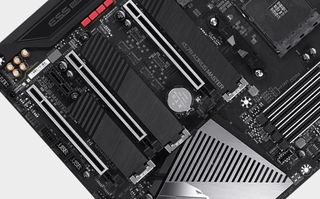PCI Express 5.0 spec is finalized just as AMD starts pushing PCIe 4.0 to Ryzen
Third-gen Ryzen’s support for PCI Express 4.0 is already last generation.

AMD's third-generation Ryzen processors aren't even available to purchase yet (they will be in July), and already one of the features that is inherent to the accompanying X570 chipset is now a previous-generation technology. That's because PCI-SIG just ratified PCI Express 5.0.
There's quite a bit to decode there, particularly if you're in the market for the best AMD motherboard, so let's get started. PCI-SIG, or Peripheral Component Interconnect Special Interest Group (rolls right off the tongue, doesn't it?), is an industry consortium that oversees the development of the PCI Express (PCIe) bus, with official standards that chip makers, motherboard makers, and other hardware outfits adhere to.
AMD earlier this week unveiled its first Ryzen 3000 series processors based on its Zen 2 CPU architecture. Combined with a motherboard built around the also-new X570 chipset, it is the first consumer platform to support PCIe 4.0, which effectively doubles the bandwidth of PCIe 3.0 between the CPU and chipset, as well as the CPU and peripherals like graphics cards and NVMe solid state drives.
Right now, that doesn't matter a whole lot for GPUs, at least as it pertains to gaming—bandwidth hasn't been a huge bottleneck, and even going from PCIe 2.0 to PCIe 3.0 doesn't yield a big bump in gaming performance. However, the standard does pave the way for faster high-end NVMe SSDs.
At Computex, we've seen a few different companies announce new PCIe 4.0 NVMe SSDs with sequential read speeds of around 5,000MB/s, such as Corsair's MP600. You don't need that kind of speed for gaming either, but for certain workloads (transferring 4K videos, for example), it has some benefit. Future M.2 drives could push transfer rates as high as 7,000MB/s with PCIe 4.0.
This brings us back to the newly ratified standard. PCIe 4.0 and related devices are just now showing up, but when it comes to technology, what was cutting edge one day is old news the next. On paper, anyway—PCIe 5.0 again doubles the bandwidth, this time from around 64GB/s to ~128GB/s via a PCIe 5.0 x16 configuration.
Here's a quick overview of how things shake out, from PCIe 1.0 to PCIe 5.0 (full duplex):
The biggest gaming news, reviews and hardware deals
Keep up to date with the most important stories and the best deals, as picked by the PC Gamer team.
- PCIe 1.0 (2003): 2.5GT/s transfer rate, ~8GB/s x16 bandwidth
- PCIe 2.0 (2007): 5.0GT/s transfer rate, ~16GB/s x16 bandwidth
- PCIe 3.0 (2010): 8.0GT/s transfer rate, ~32GB/s x16 bandwidth
- PCIe 4.0 (2017): 16.0 GT/s transfer rate, ~64GB/s x16 bandwidth
- PCIe 5.0 (2019): 32.0 GT/s transfer rate, ~128GB/s x16 bandwidth
"New data-intensive applications are driving demand for unprecedented levels of performance," said Al Yanes, PCI-SIG chairman and president. "Completing the PCIe 5.0 specification in 18 months is a major achievement, and it is due to the commitment of our members who worked diligently to evolve PCIe technology to meet the performance needs of the industry. The PCIe architecture will continue to stand as the defacto standard for high performance I/O for the foreseeable future."
Just as PCIe 4.0 is starting to do now, PCIe 5.0 will enable faster devices...someday. It will likely be a couple of years before platforms actually implement support. AMD, after all, is just now rolling out support for PCIe 4.0, and Intel is still utilizing PCIe 3.0 in its latest platforms.
“AMD congratulates PCI-SIG on the release of the PCI Express 5.0 specification to the industry and the future 2x increase in performance it is expected to deliver. We expect to bring our first PCIe 4.0 specification CPUs to market this year and look forward to meeting the future bandwidth demands of end-users with PCIe 5.0 technology," AMD said in a statement.
Intel also said it plans to support PCIe 5.0, which is really just stating the obvious, while Nvidia said the newly ratified standard "will advance graphics and high-performance computing."
So, even though the third-gen Ryzen platform is now utilizing a last-gen PCIe standard, it's not obsolete by any means. In other words, don't pause plans to upgrade just because PCIe 5.0 is now official, not unless you want to wait a long time.
Paul has been playing PC games and raking his knuckles on computer hardware since the Commodore 64. He does not have any tattoos, but thinks it would be cool to get one that reads LOAD"*",8,1. In his off time, he rides motorcycles and wrestles alligators (only one of those is true).
Most Popular






